Linux知识点 – Linux多线程(一)
文章目录
一、理解线程
1.从资源角度理解线程
- Linux中的线程:
通过一定的技术手段,将当前进程的资源,以一定的方式划分给不同的task_strcut,这里的每一个task_struct可以称之为一个线程;这些线程对应的都是统一的地址空间和页表;
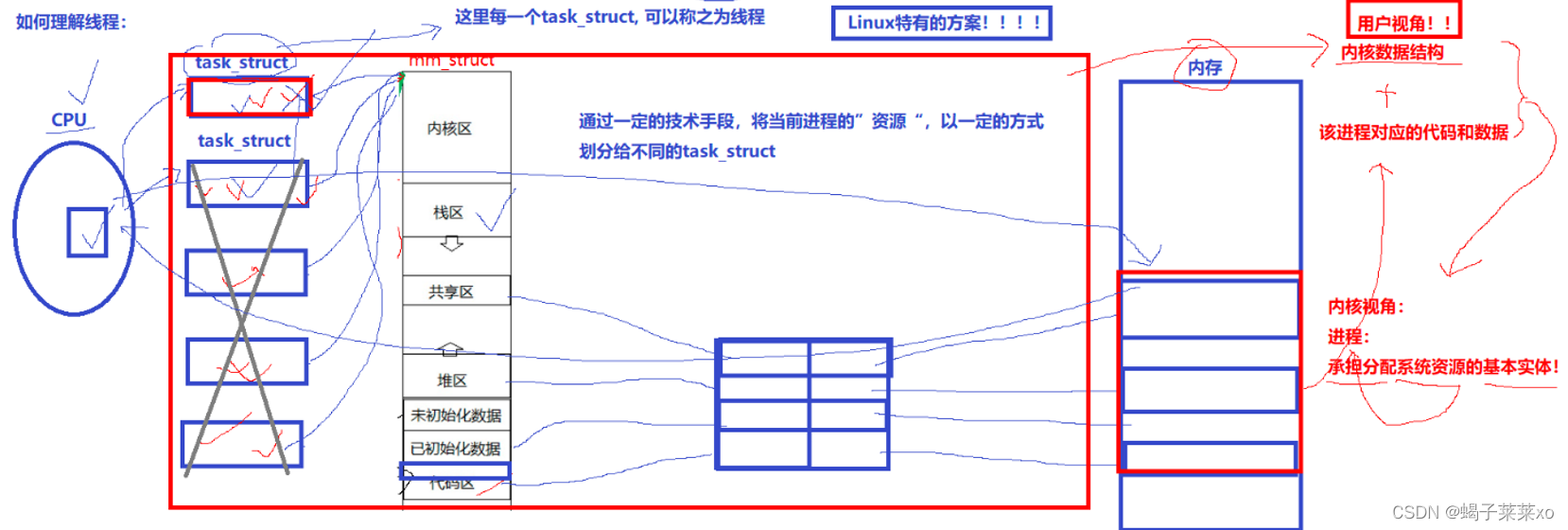
这是Linux系统下的特有的线程解决方案; - 从内核视角来看,进程是承担分配资源的基本实体,因为在OS看来,进程和线程的结构都是task_struct,而线程会划分进程的资源,因此进程是申请资源的最小单位;
- 线程是在进程内部执行,是OS调度的基本单位;
线程在进程的地址空间内运行,CPU其实并不关心执行流是进程还是线程,只关心PCB;
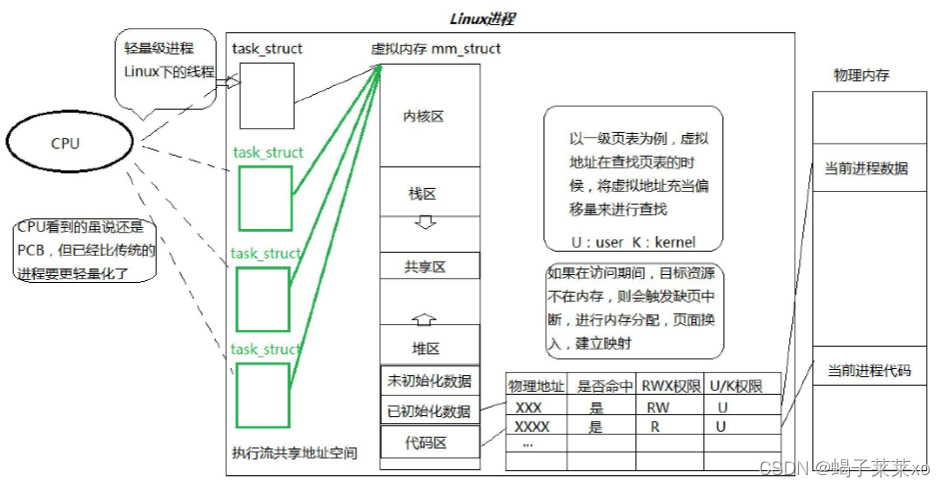
2.执行流
- 我们以前写过的代码都是内部只有一个执行流的代码,而多线程就是有多个执行流;
- 进程 = 执行流(至少一个) + 内核数据结构 + 进程对应的代码和数据
- task_struct就是进程内部的一个执行流,CPU其实不关心当前是进程还是线程,站在CPU的角度,看到的都是task_struct;
- 其实Linux系统下没有真正意义上的线程结构,Linux是用进程PCB来模拟线程结构的,因此Linux下的进程统一称为:=轻量级进程;Linux系统下,在CPU眼中,看到的PCB都要比传统的进程更加轻量化;
- Linux并不能直接给我们提供线程相关的接口,只能提供轻量级进程的接口;
- 线程的实现是在用户层实现了一套多线程方案,以库的方式提供给用户进行使用,pthread线程库就是Linux的原生线程库;
3.多线程编程
使用pthread线程库中的接口就可以实现Linux系统下的多线程;

- 参数:
thread:线程id
attr:线程属性(默认)
start_routine:函数指针,执行进程代码一部分时的入口函数
arg:传递给函数指针的参数,完成函数回调
返回值:成功返回0;失败返回错误码
makefile:
mythread:mythread.cpp
g++ -o $@ $^ -lpthread
.PHONY:clean
clean:
rm -f mythread
-lpthread参数的作用是引入线程库;
因为多线程的创建方法是库提供的,所以必须引入该库;
如果编译时不加-lpthread:

mythread.cpp
#include<iostream>
#include<string>
#include<cstdio>
#include<unistd.h>
#include<pthread.h>
using namespace std;
//pthread函数的回调函数参数,传的是返回值是void*的函数指针,函数的参数也是void*
void* threadRun(void* args)
{
const string name = (char*)args;
while(true)
{
cout << name << ", pid: " << getpid() << "\n" << endl;
sleep(1);
}
}
int main()
{
pthread_t tid[5];
char name[64];
for(int i = 0; i < 5; i++)
{
snprintf(name, sizeof(name), "%s-%d", "thread", i);
pthread_create(tid+i, nullptr, threadRun, (void*)name);
sleep(1);//缓解传参的bug
}
while(true)
{
cout << "main thread, pid: " << getpid() << endl;
sleep(3);
}
return 0;
}
上述代码在一个进程内创建了5个线程,每个线程都运行了threadRun函数,打印出他们的PID;
运行结果:
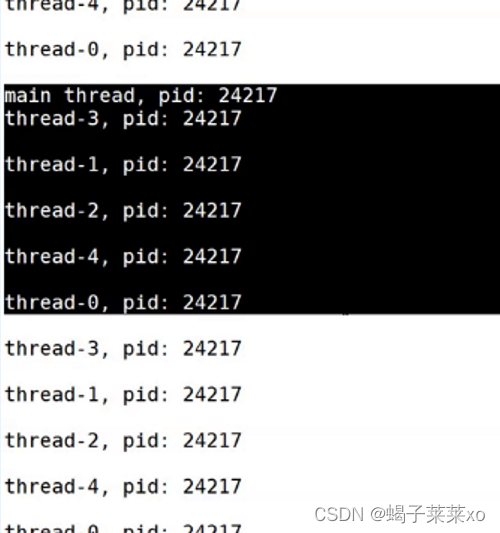
这些线程的pid都是一样的,证明线程在进程内部运行;

在用户层面上看到的只是一个进程;
可以使用ps -aL代码产看线程,-L就是查看轻量级进程的选项;

LWP是轻量级进程PID,这些是不一样的,第一个PID和LWP是一样的,就叫做主线程;
OS调度的时候,看的是LWP;
所有的线程都是使用进程的资源,一旦进程退出,所有线程都退出;
4.线程的资源
-
进程的多个线程共享同一地址空间,如果定义一个函数,各线程都可以调用;如果定义一个全局变量,各线程都可以访问;除此之外,各线程还共享以下资源和环境:
文件描述符;
每种信号的处理方式;
当前工作目录;
用户id和组id; -
线程共享进程数据,但也拥有自己的一部分数据:
线程ID;
一组寄存器;
栈;
errno;
信号屏蔽字;
调度优先级;
(其中,栈和寄存器代表着线程的动态属性,寄存器就是线程的山下文)
5.线程切换的成本更低
- 切换线程不需要切换地址空间和页表;
- CPU内部有L1~L3的cache(缓存:对内存中的代码和数据,根据局部性原理,预读到CPU内部;)
如果进程切换,cache就立即失效,新进程过来,只能重新缓存;而线程切换不需要刷新缓存;
6.线程的优缺点
-
优点
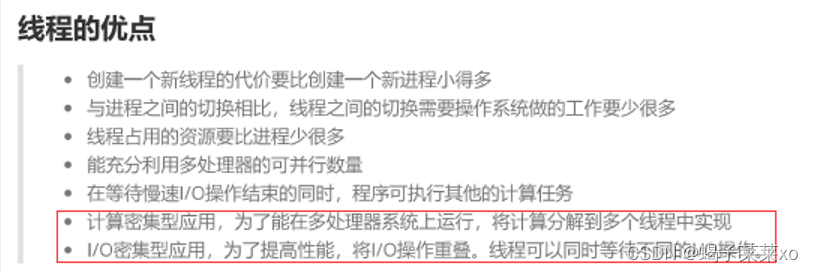
-
缺点
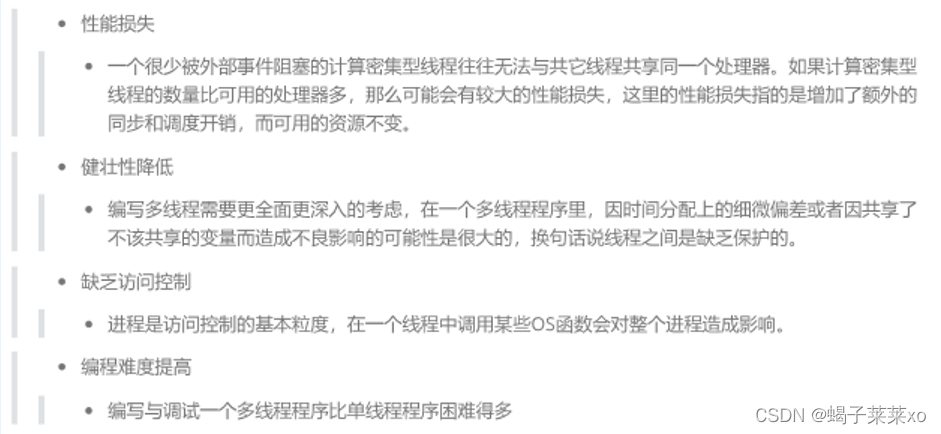
7.线程异常
- 单个线程如果出现除0、野指针等问题导致线程崩溃,进程也会随着崩溃;
- 线程是进程的执行分支,线程出现异常,就类似进程出现异常,进而触发信号机制,进程终止,该进程内所有的线程也随之退出;
二、线程控制
1.clone函数

fork创建多进程,底层调用的就是clone函数;
创建多线程底层也需要调用clone函数;
2.线程异常
当一个线程触发除0错误时:
#include <iostream>
#include <string>
#include <cstdio>
#include <unistd.h>
#include <pthread.h>
using namespace std;
// pthread函数的回调函数参数,传的是返回值是void*的函数指针,函数的参数也是void*
void *threadRoutine(void *args)
{
while (true)
{
cout << "new thread: " << (char *)args << " running ..." << endl;
sleep(1);
int a = 10;
a /= 0;
}
}
int main()
{
pthread_t tid;
pthread_create(&tid, nullptr, threadRoutine, (void *)"thread 1");
while (true)
{
cout << "main thread: " << " running ..." << endl;
sleep(1);
}
return 0;
}
运行结果:

一个线程异常退出,整个进程都会退出;
3.线程等待
线程在创建并执行的时候,主线程也是需要等待的,如果主线程不等待,就会引发类似于进程的僵尸问题,导致内存泄漏;
- pthread_join接口:线程等待

参数:
thread:线程id;
retval:void**类型,用来拿到线程执行的结果;
#include <iostream>
#include <string>
#include <cstdio>
#include <unistd.h>
#include <pthread.h>
using namespace std;
// pthread函数的回调函数参数,传的是返回值是void*的函数指针,函数的参数也是void*
void *threadRoutine(void *args)
{
int i = 0;
while (true)
{
cout << "new thread: " << (char *)args << " running ..." << endl;
sleep(1);
if(i++ == 3)
break;
}
}
int main()
{
pthread_t tid;
pthread_create(&tid, nullptr, threadRoutine, (void *)"thread 1");
pthread_join(tid, nullptr);//默认会阻塞等待新线程退出
cout << "main thread wait done ... main quit\n ";
// while (true)
// {
// cout << "main thread: " << " running ..." << endl;
// sleep(1);
// }
return 0;
}
上面的代码,新线程运行完threadRoutine函数就会退出,而主线程pthread_join会默认阻塞等待新线程退出,然后回回收新线程资源;
监控脚本:
while :; do ps -aL | head -1 && ps -L | grep mythread; sleep 1; done
运行结果:

主线程会等待新线程退出后,清理完资源再退出;
4.回调函数的返回值
pthread_join的第二个参数是void**类型,是用来拿到线程执行结果的;
#include <iostream>
#include <string>
#include <cstdio>
#include <unistd.h>
#include <pthread.h>
using namespace std;
// pthread函数的回调函数参数,传的是返回值是void*的函数指针,函数的参数也是void*
void *threadRoutine(void *args)
{
int i = 0;
while (true)
{
cout << "new thread: " << (char *)args << " running ..." << endl;
sleep(1);
if(i++ == 3)
break;
}
cout << "new thread quit" << endl;
return (void*)10;
}
int main()
{
pthread_t tid;
pthread_create(&tid, nullptr, threadRoutine, (void *)"thread 1");
void* ret = nullptr;
pthread_join(tid, &ret);//默认会阻塞等待新线程退出
cout << "main thread wait done ... main quit\n ";
cout << "ret: " << (long long)ret << endl;
return 0;
}
在上面代码中:
- ret是指针变量,开辟了void*大小的空间,Linux是64位系统,地址为8字节;
- 指针是一个常量,指向一个地址,指针变量是存放指针数据的变量;
- 回调函数的返回值类型是void*;
- 果需要拿到一个void*类型的返回值,就需要使用void**类型;
- 这里返回的时候将10强转为void*类型,意味着10现在是一个指针,代表地址;在用void**类型拿到返回值之后,解引用一下就是10这个指针;
- 因为Linux地址是8字节的,因此拿到返回值后,使用的时候需要强转为long long类型
运行结果:
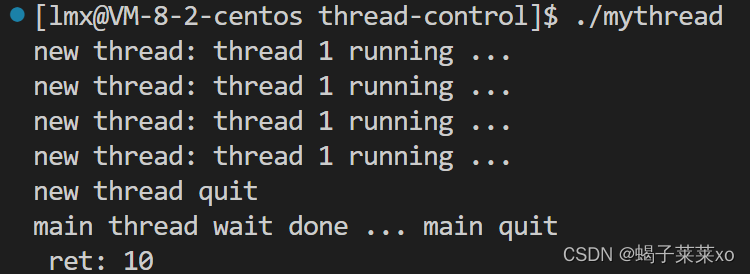
还可以拿到新线程在堆上申请空间后的返回结果:
#include <iostream>
#include <string>
#include <cstdio>
#include <unistd.h>
#include <pthread.h>
using namespace std;
// pthread函数的回调函数参数,传的是返回值是void*的函数指针,函数的参数也是void*
void *threadRoutine(void *args)
{
int i = 0;
int* data = new int[3];//新线程申请空间
while (true)
{
cout << "new thread: " << (char *)args << " running ..." << endl;
sleep(1);
data[i] = i;
if(i++ == 3)
break;
}
cout << "new thread quit" << endl;
return (void*)data;//返回空间的地址
}
int main()
{
pthread_t tid;
pthread_create(&tid, nullptr, threadRoutine, (void *)"thread 1");
int* ret = nullptr;
pthread_join(tid, (void**)&ret);//默认会阻塞等待新线程退出
cout << "main thread wait done ... main quit\n ";
for(int i = 0; i < 3; i++)
{
cout << ret[i] << endl;
}
return 0;
}
运行结果:
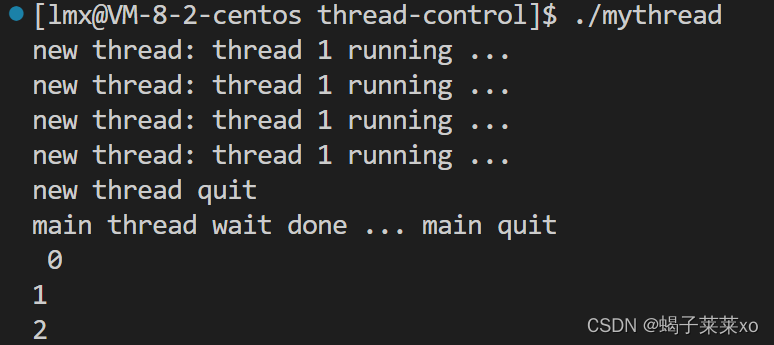
- 注:pthread_join函数不会拿到线程的退出码,这是因为一个线程出问题,整个进程都会退出;
5.线程退出
#include <iostream>
#include <string>
#include <cstdio>
#include <unistd.h>
#include <pthread.h>
using namespace std;
// pthread函数的回调函数参数,传的是返回值是void*的函数指针,函数的参数也是void*
void *threadRoutine(void *args)
{
int i = 0;
int* data = new int[3];//新线程申请空间
while (true)
{
cout << "new thread: " << (char *)args << " running ..." << endl;
sleep(1);
data[i] = i;
if(i++ == 3)
break;
}
exit(10);
cout << "new thread quit" << endl;
return (void*)data;//返回空间的地址
}
int main()
{
pthread_t tid;
pthread_create(&tid, nullptr, threadRoutine, (void *)"thread 1");
int* ret = nullptr;
pthread_join(tid, (void**)&ret);//默认会阻塞等待新线程退出
cout << "main thread wait done ... main quit\n ";
for(int i = 0; i < 3; i++)
{
cout << ret[i] << endl;
}
return 0;
}
运行结果:

可以看出,新线程调用了exit函数退出后,后面的代码都不运行了;
线程内部调用exit,整个进程都会退出;
- 线程退出使用pthread_exit接口:
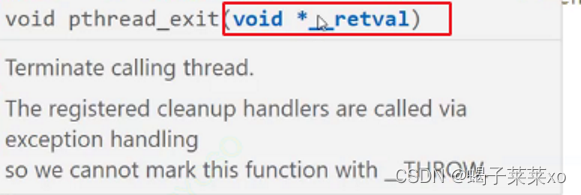
参数:
__retval:void*类型的参数,相当于进程退出码,能够用pthread_join接口拿到;
#include <iostream>
#include <string>
#include <cstdio>
#include <unistd.h>
#include <pthread.h>
using namespace std;
// pthread函数的回调函数参数,传的是返回值是void*的函数指针,函数的参数也是void*
void *threadRoutine(void *args)
{
int i = 0;
int* data = new int[3];//新线程申请空间
while (true)
{
cout << "new thread: " << (char *)args << " running ..." << endl;
sleep(1);
data[i] = i;
if(i++ == 3)
break;
}
cout << "new thread quit" << endl;
pthread_exit((void*)11);//退出码是11
}
int main()
{
pthread_t tid;
pthread_create(&tid, nullptr, threadRoutine, (void *)"thread 1");
int* ret = nullptr;
pthread_join(tid, (void**)&ret);//默认会阻塞等待新线程退出
cout << "main thread wait done ... main quit\n ";
cout << "ret: " << (long long)ret << endl;
return 0;
}
运行结果:

6.线程取消
- pthread_cancle:
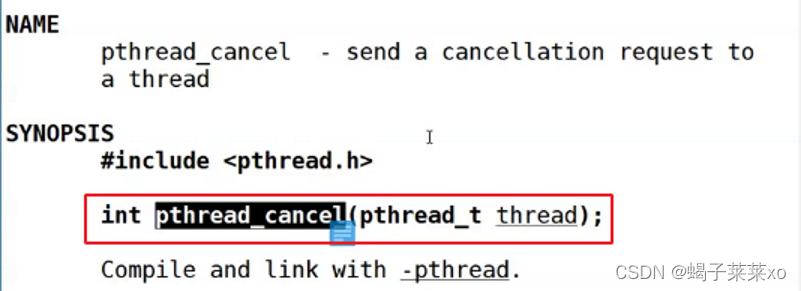
参数:
thread:线程id;
#include <iostream>
#include <string>
#include <cstdio>
#include <unistd.h>
#include <pthread.h>
using namespace std;
// pthread函数的回调函数参数,传的是返回值是void*的函数指针,函数的参数也是void*
void *threadRoutine(void *args)
{
while (true)
{
cout << "new thread: " << (char *)args << " running ..." << endl;
sleep(1);
}
cout << "new thread quit" << endl;
}
int main()
{
pthread_t tid;
pthread_create(&tid, nullptr, threadRoutine, (void *)"thread 1");
int count = 0;
while (true)
{
cout << "main thread: "
<< " running ..." << endl;
sleep(1);
count++;
if (count == 5)
break;
}
pthread_cancel(tid);
cout << "pthread cancle: " << tid << endl;
int *ret = nullptr;
pthread_join(tid, (void **)&ret); // 默认会阻塞等待新线程退出
cout << "main thread wait done ... main quit\n ";
sleep(5);
return 0;
}
上面的代码:新线程一直运行,由主线程取消新线程;
运行结果:
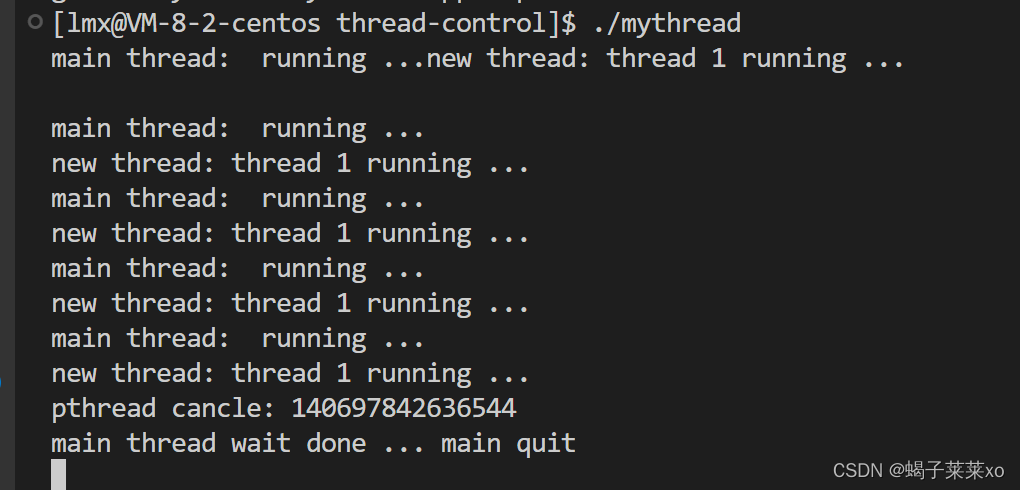
- 注意:
(1)线程被取消,主线程等待的时候,退出码是-1;

(2) 取消进程的使用场景为:新线程已经跑了一段时间了,主线程想要取消它;
(3)不要使用新线程取消主线程,因为主线程承担调用join去回收新线程;
7.线程id
打印出线程id:


与LWP是不同的:

因为线程id的本质是一个地址;
我们目前使用的不是Linux自带的创建线程的接口,我们用的是pthread库中的接口;
线程运行需要有独立的栈区,保证栈区是每一个线程独占的方法是:由用户层提供栈区;
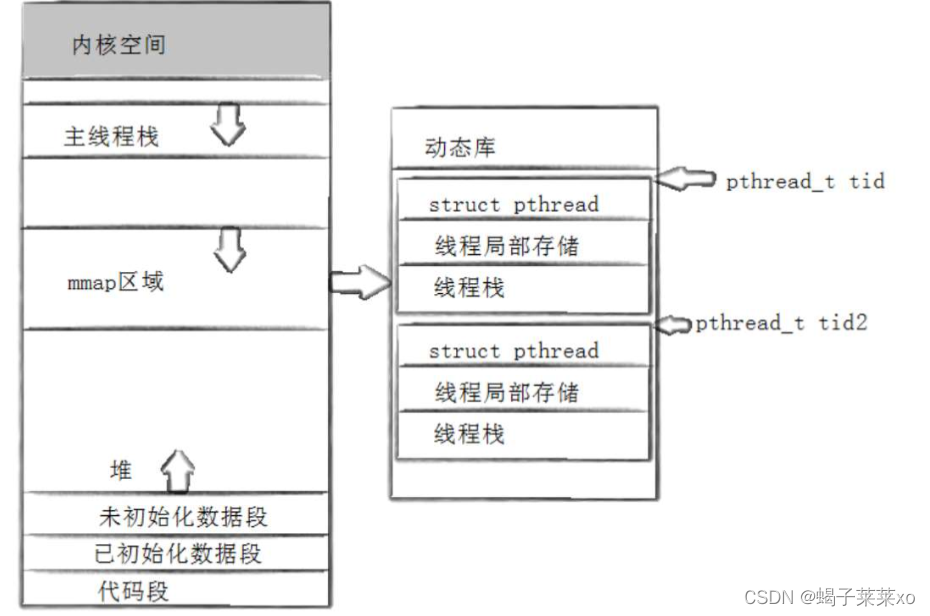
- pthread库内部会管理维护每个线程的私有数据;
- 线程的栈区是由库提供的,就在共享区;
- 因此线程id就代表该线程在库内部的属性数据的起始地址;
- 主线程用的是内核级的栈区,新线程用的是库提供的栈区,在共享区;
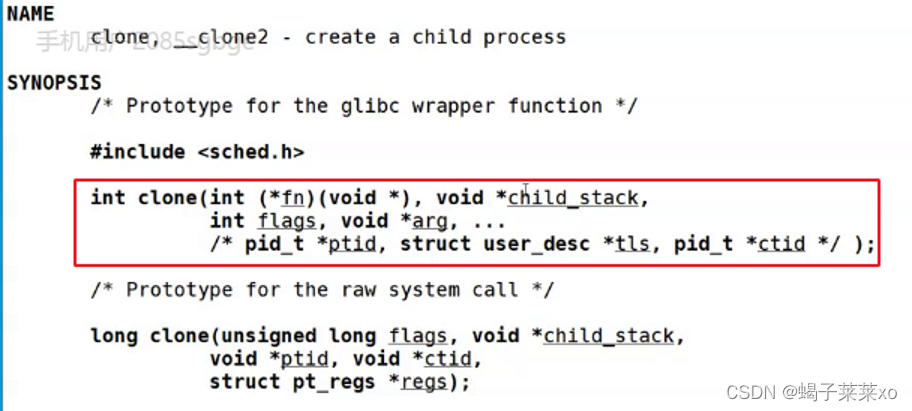
新线程的栈区底层就是用clone函数实现的,child_stack参数就是栈区的地址;
线程可以自己获取自己的id:
#include <iostream>
#include <string>
#include <cstdio>
#include <unistd.h>
#include <pthread.h>
using namespace std;
// pthread函数的回调函数参数,传的是返回值是void*的函数指针,函数的参数也是void*
void *threadRoutine(void *args)
{
while (true)
{
cout << "new thread: " << (char *)args << " running ..." << pthread_self() << endl;
sleep(1);
}
cout << "new thread quit" << endl;
}
int main()
{
pthread_t tid;
pthread_create(&tid, nullptr, threadRoutine, (void *)"thread 1");
while (true)
{
cout << "main thread: "
<< " running ..." << endl;
sleep(1);
}
int *ret = nullptr;
pthread_join(tid, (void **)&ret); // 默认会阻塞等待新线程退出
cout << "main thread wait done ... main quit\n ";
return 0;
}
运行结果:

8.线程局部存储
#include <iostream>
#include <string>
#include <cstdio>
#include <unistd.h>
#include <pthread.h>
using namespace std;
int g_val = 0;
// pthread函数的回调函数参数,传的是返回值是void*的函数指针,函数的参数也是void*
void *threadRoutine(void *args)
{
while (true)
{
cout << (char *)args << " : " << g_val << &g_val << endl;
sleep(1);
g_val++;
}
int main()
{
pthread_t tid;
pthread_create(&tid, nullptr, threadRoutine, (void *)"thread 1");
while (true)
{
cout << "main thread: " << " : " << g_val << &g_val << endl;
sleep(1);
}
return 0;
}
上面的代码创建了一个全局变量,由主线程和新线程同时访问:
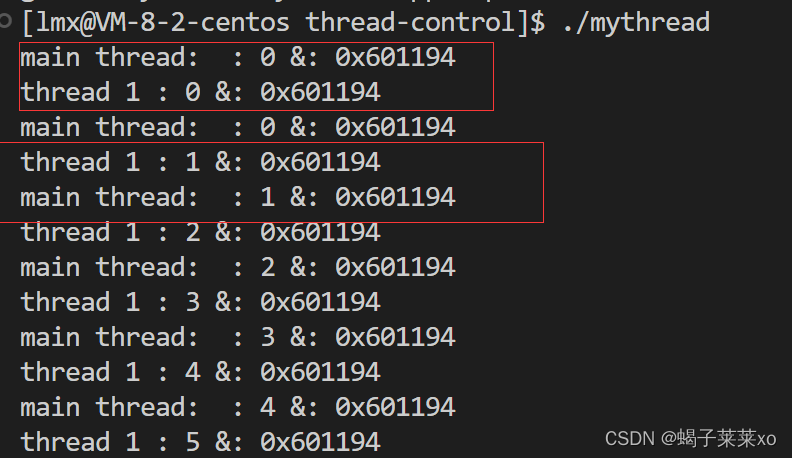
可以看到,所有进程是共享全局变量的;
- __thread:将全局变量变成每个线程私有:
在全局变量前面加上__thread修饰:

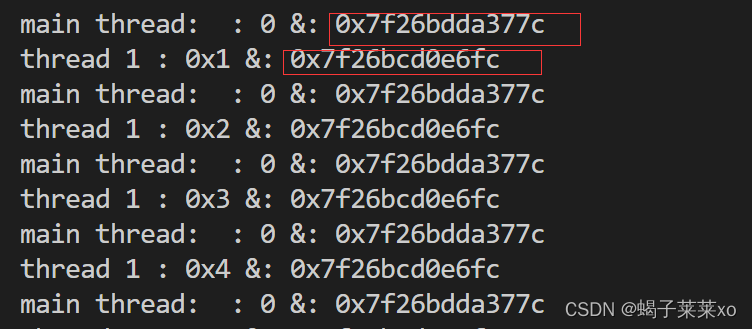
两个线程就访问的是各自的全局变量了,让每一个线程各自拥有一个全局变量;
9.程序替换
如果在线程的内部调用函数替换:
#include <iostream>
#include <string>
#include <cstdio>
#include <unistd.h>
#include <pthread.h>
using namespace std;
__thread int g_val = 0;
// pthread函数的回调函数参数,传的是返回值是void*的函数指针,函数的参数也是void*
void *threadRoutine(void *args)
{
sleep(5);
execl("/bin/ls", "ls");
while (true)
{
cout << (char *)args << " : " << g_val << " &: " << &g_val << endl;
sleep(1);
g_val++;
}
}
int main()
{
pthread_t tid;
pthread_create(&tid, nullptr, threadRoutine, (void *)"thread 1");
while (true)
{
cout << "main thread: " << " : " << g_val << " &: "<< &g_val << endl;
sleep(1);
//count++;
// if (count == 5)
// break;
}
return 0;
}
运行结果:

在线程内部进行程序替换,会导致整个进程都被替换,整个进程直接执行替换的程序;
10.分离线程
- 默认情况下,新创建的线程是joinable的,线程退出后,需要对其进行pthread_join操作,否组无法释放资源;
- 如果不关心线程的返回,join是一种负担,这个时候可以告诉系统,当线程退出时,自动释放线程资源,这就是线程分离;
- pthread_detach:线程分离接口;
#include <iostream>
#include <string>
#include <cstdio>
#include <cstring>
#include <cerrno>
#include <unistd.h>
#include <pthread.h>
using namespace std;
__thread int g_val = 0;
// pthread函数的回调函数参数,传的是返回值是void*的函数指针,函数的参数也是void*
void *threadRoutine(void *args)
{
pthread_detach(pthread_self());
while (true)
{
cout << (char *)args << " : " << g_val << " &: " << &g_val << endl;
sleep(1);
g_val++;
// data[i] = i;
// if(i++ == 3)
break;
}
pthread_exit((void*)11);//退出码是11
}
int main()
{
pthread_t tid;
pthread_create(&tid, nullptr, threadRoutine, (void *)"thread 1");
while (true)
{
cout << "main thread: " << " : " << g_val << " &: "<< &g_val << endl;
sleep(1);
break;
}
int n = pthread_join(tid, nullptr);
cout << "errstring: " << strerror(n) << endl;
return 0;
}
运行结果:

当线程分离后再等待新线程退出,就会报错;
11.C++提供的线程库
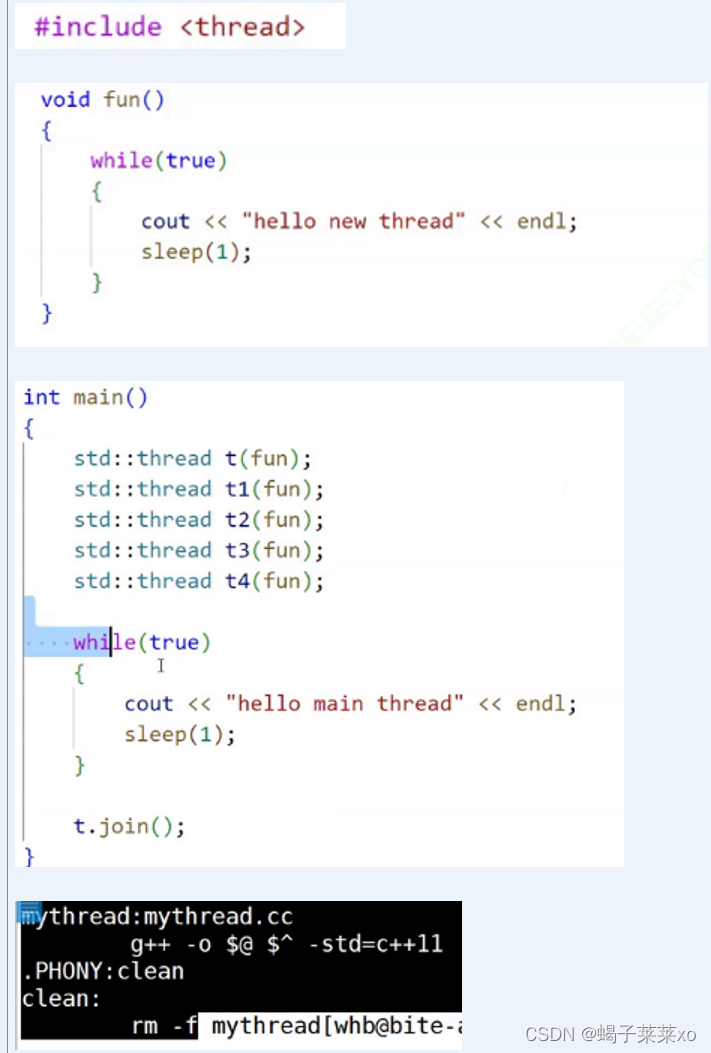
这样会报错:

加上pthread库的编译选项:

就可以运行了:
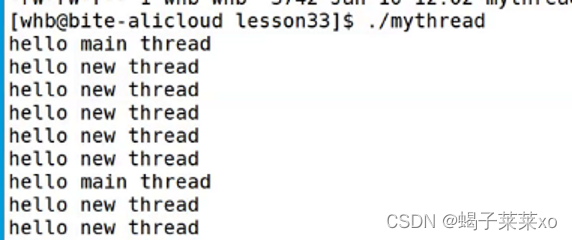
因为语言级别的线程库底层使用的是原生线程库,都是对原生线程库的封装;





















 1873
1873











 被折叠的 条评论
为什么被折叠?
被折叠的 条评论
为什么被折叠?








